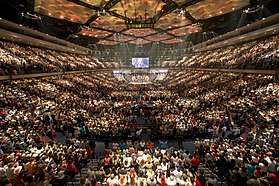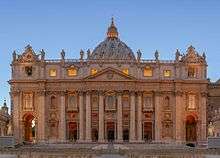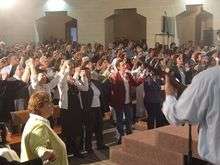Charismatic movement
The charismatic movement is the international trend of historically mainstream Christian congregations adopting beliefs and practices similar to Pentecostalism. Fundamental to the movement is the use of spiritual gifts (charismata). Among mainline Protestants, the movement began around 1960. Among Roman Catholics, it originated around 1967.
| Part of a series on |
| Christianity |
|---|
 |
|
|
|
|
|
History
The classic Pentecostalism movement usually traces its origin to the early twentieth century, with the ministry of Charles F. Parham[1] and the subsequent ministry of William Joseph Seymour and the Azusa Street Revival.[2] Its unique doctrine involved a dramatic encounter with God, termed baptism with the Holy Spirit. The evidence for having received this experience was interpreted by some as speaking in tongues.[3]
Before 1955 the religious mainstream did not embrace Pentecostal doctrines. If a church member or clergyman openly expressed such views, they would (either voluntarily or involuntarily) separate from their existing denomination. However, by the 1960s many of the characteristic teachings were gaining acceptance among Christians within mainline Protestant denominations.[4] The charismatic movement represented a reversal of this previous pattern as those influenced by Pentecostal spirituality chose to remain in their original denominations.[5] The popularization and broader acceptance of charismatic teachings as well as ideas are linked to the healing revivals that occurred from 1946 to 1958. The revivalists of the time, including William Branham, Oral Roberts, and A. A. Allen, held large interdenominational meetings which emphasized the gifts of the spirit. This global revival led to greater awareness and acceptance of Pentecostal teachings and practices.[6]
The high church wing of the American Episcopal Church became the first traditional ecclesiastical organization to feel the impact of the new movement internally. The beginning of the charismatic movement is usually dated to Sunday, April 3, 1960, when Dennis J. Bennett, rector of St Mark's Episcopal Church in Van Nuys, California recounted his Pentecostal experience to his parish, doing it again on the next two Sundays, including Easter (April 17), during which many of his congregation shared his experience, causing him to be forced to resign.[7] The resulting controversy and press coverage spread an awareness of the emerging charismatic movement. The movement grew to embrace other mainline churches, where clergy began receiving and publicly announcing their Pentecostal experiences. These clergy began holding meetings for seekers and healing services which included praying over and anointing of the sick. The Catholic Charismatic Renewal began in 1967 at Duquesne University in Pittsburgh, Pennsylvania.[8]
Despite the fact that Pentecostals currently tend to share more in common with evangelicals than with either Roman Catholics or non-evangelical wings of the church,[9] the charismatic movement was not initially influential among evangelical churches. C. Peter Wagner traces the spread of the charismatic movement within evangelicalism to around 1985. He termed this movement the Third Wave of the Holy Spirit.[10] The Third Wave has expressed itself through the formation of churches and denomination-like organizations. These groups are referred to as "neo-charismatic".[11] The Vineyard Movement and the British New Church Movement exemplify Third Wave or neo-charismatic organizations.
Beliefs
Charismatic Christians believe that the gifts (Greek charismata χαρίσματα, from charis χάρις, grace) of the Holy Spirit as described in the New Testament are available to contemporary Christians through the infilling or baptism of the Holy Spirit, with or without the laying on of hands.[12] Although the Bible lists many gifts from God through his Holy Spirit, there are nine specific gifts listed in 1 Corinthians 12:8–10 that are supernatural in nature and are the focus of and distinguishing feature of the charismatic movement: word of wisdom, word of knowledge, faith, gifts of healing, miraculous powers, prophecy, distinguishing between spirits, speaking in different tongues (languages), and interpretation of tongues.
While Pentecostals and charismatics share these beliefs, there are differences. Many in the charismatic movement deliberately distanced themselves from Pentecostalism for cultural and theological reasons. Foremost among theological reasons is the tendency of many Pentecostals to insist that speaking in tongues is always the initial physical sign of receiving Spirit baptism. Although specific teachings will vary from group to group, charismatics generally believe that the baptism with the Holy Spirit occurs at the new birth and prefer to call subsequent encounters with the Holy Spirit by other names, such as "being filled".[12] In contrast to Pentecostals, charismatics tend to accept a range of supernatural experiences (such as prophecy, miracles, healing, or "physical manifestations of an altered state of consciousness") as evidence of having been baptized or filled with the Holy Spirit.[13]
Pentecostals are also distinguished from the charismatic movement on the basis of style.[14] Also, Pentecostals have traditionally placed a high value on evangelization and missionary work. Charismatics, on the other hand, have tended to see their movement as a force for revitalization and renewal within their own church traditions.[15]
Cessationists argue these sign and revelatory gifts were manifested in the New Testament for a specific purpose, upon which once accomplished these signs were withdrawn and no longer function.[16] This position is claimed by its proponents to be the almost universal position of Christians until the Charismatic movement started.[16] The Charismatic movement is based on a belief that these gifts are still available today.
Denominations influenced
| Part of a series on |
| Protestantism |
|---|
 |
|
Major branches |
|
Minor branches |
|
Broad-based movements |
|
Related movements |
|
|
Anglicanism
In America, the Episcopalian Dennis Bennett is sometimes cited as one of the charismatic movement's seminal influence.[17] Bennett was the Rector at St Mark's Episcopal Church in Van Nuys, California when he announced to the congregation in 1960 that he had received the outpouring of the Holy Spirit.[18] Soon after this he ministered in Seattle, where he ran many workshops and seminars about the work of the Holy Spirit.[19]
In the United Kingdom, Colin Urquhart, Michael Harper, David Watson and others were in the vanguard of similar developments.
The Massey conference in New Zealand, 1964 was attended by several Anglicans, including the Rev. Ray Muller, who went on to invite Bennett to New Zealand in 1966, and played a leading role in developing and promoting the Life in the Spirit seminars. Other Charismatic movement leaders in New Zealand include Bill Subritzky.
As of the early 21st century a "charismatic evangelical" wing or school of thought is commonly identified in the Church of England, contrasted with the conservative evangelical, Anglo-Catholic and other tendencies. An influential local church in this movement has been London's Holy Trinity Brompton, and Justin Welby, Archbishop of Canterbury since 2013, has a background in charismatic evangelicalism.[20]
Evangelicalism

The movement led to the creation of independent evangelical charismatic churches more in tune with the revival of the Holy Spirit. These churches are often nondenominational. Calvary Chapel Costa Mesa, California was one of the first evangelical charismatic churches, founded in 1965.[21] In the United Kingdom, Jesus Army, founded in 1969, is an example of the impact outside of the United States.[22] Many other congregations were established in the rest of the world.[23]
Lutheranism
Larry Christenson, a Lutheran theologian based in San Pedro, California, did much in the 1960s and 1970s to interpret the charismatic movement for Lutherans. A very large annual conference was held in Minneapolis during those years.[24]. Lutheran charismatics in the US formed the Alliance of Renewal Churches. Richard A. Jensen's Touched by the Spirit published in 1974, played a major role of the Lutheran understanding to the charismatic movement. Another Lutheran charismatic leader is Morris Vaagenes. In Finland the emergence of charismatic congregations has reversed, in some places, a decline in attendance of Lutheran congregations.[25]
Methodism
When the Methodist movement was initiated, "many individuals in London, Oxford and Bristol reported supernatural healings, visions, dreams, spiritual impressions, power in evangelizing, [and] extraordinary bestowments of wisdom".[26] John Wesley, the founder of Methodism, "firmly maintained that the Spiritual gifts are a natural consequence of genuine holiness and dwelling of God's Spirit in a man."[26] As such, Methodist Churches hold to the theological position of continuationism.[26] With its history of promoting holiness and experiential faith, Methodist Churches permit charismatic worship.[27]
Charismatics in the United States allied with the Good News caucus and those in Great Britain have been supported by the Lay Witness Movement,[28] which works with Methodist Evangelicals Together.[27] In the United Methodist Church, the charismatic apostolate Aldersgate Renewal Ministries was formed "to pray and work together for the renewal of the church by the power of the Holy Spirit".[29] It runs events at local United Methodist churches, as well as the Methodist School for Supernatural Ministry.[29]
Calvinism
In congregational and Presbyterian churches which profess a traditionally Calvinist or Reformed theology, there are differing views regarding present-day continuation or cessation of the gifts (charismata) of the Spirit.[16][30] Generally, however, Reformed charismatics distance themselves from renewal movements with tendencies which could be perceived as overemotional, such as Word of Faith, Toronto Blessing, Brownsville Revival and Lakeland Revival.
Prominent Reformed charismatic denominations are the Sovereign Grace Churches and the Every Nation Churches in the United States, in Great Britain there is the Newfrontiers churches and movement, founded by Terry Virgo.[31]
Adventism
A minority of Seventh-day Adventists today are charismatic. They are strongly associated with those holding more "progressive" Adventist beliefs. In the early decades of the church charismatic or ecstatic phenomena were commonplace.[32][33]
Roman Catholicism
| Part of a series on the |
| Catholic Church |
|---|
 |
| Overview |
|
Miscellaneous
Relations with: |
|
|

In the United States the Catholic Charismatic Renewal was focused in individuals like Kevin Ranaghan and others at the University of Notre Dame in Notre Dame, Indiana. Duquesne University in Pittsburgh, which was founded by the Congregation of the Holy Spirit, a Catholic religious community, began hosting charismatic revivals in 1977.
In a foreword to a 1983 book by Léon Joseph Cardinal Suenens, at that time the Pope's delegate to the Catholic Charismatic Renewal, the prefect comments on the Post Second Vatican Council period stating,
At the heart of a world imbued with a rationalistic skepticism, a new experience of the Holy Spirit suddenly burst forth. And, since then, that experience has assumed a breadth of a worldwide Renewal movement. What the New Testament tells us about the Charisms—which were seen as visible signs of the coming of the Spirit—is not just ancient history, over and done with, for it is once again becoming extremely topical.
and
to those responsible for the ecclesiastical ministry—from parish priests to bishops—not to let the Renewal pass them by but to welcome it fully; and on the other (hand) ... to the members of the Renewal to cherish and maintain their link with the whole Church and with the Charisms of their pastors.[34]
In the Roman Catholic church, the movement became particularly popular in the Filipino, Korean, and Hispanic communities of the United States, in the Philippines, and in Latin America, mainly Brazil. Travelling priests and lay people associated with the movement often visit parishes and sing what are known as charismatic masses. It is thought to be the second largest distinct sub-movement (some 120 million members) within global Catholicism, along with Traditional Catholicism.[35]
A further difficulty is the tendency for many charismatic Catholics to take on what others in their church might consider sacramental language and assertions of the necessity of "Baptism in the Holy Spirit," as a universal act. This causes difficulty as there is little to distinguish the "Baptism" from the sacrament of confirmation.[36] In this regard, a Study seminar organized jointly in São Paulo by the Pontifical Council for Promoting Christian Unity and the Bishops Conference of Brazil raised these issues. Technically, among Catholics, the "Baptism of the Holy Spirit" is neither the highest nor fullest manifestation of the Holy Spirit.
Thus "Baptism of the Spirit" is one experience among many within Christianity (as are the extraordinary manifestations of the Spirit in the lives of the saints, notably St. Francis of Assisi and St. Teresa of Avila, who levitated), and thus less dogmatically held by Catholic charismatics (than by Pentecostals).[37] Possibly, Padre Pio (now St. Pio) provides a modern-day Catholic example of this experience. Describing his confirmation, when he was 12 years old, Padre Pio said that he "wept with consolation" whenever he thought of that day because "I remember what the Most Holy Spirit caused me to feel that day, a day unique and unforgettable in all my life! What sweet raptures the Comforter made me feel that day! At the thought of that day, I feel aflame from head to toe with a brilliant flame that burns, consumes, but gives no pain." In this experience, Padre Pio said he was made to feel God's "fullness and perfection." Thus a case can be made that he was "baptized by the Spirit" on his confirmation day in 1899. It was one spiritual experience among many that he would have.[38]
The Compendium to the Catechism of the Catholic Church states:
160. What are Charisms? 799–801. Charisms are special gifts of the Holy Spirit which are bestowed on individuals for the good of others, the needs of the world, and in particular for the building up of the Church. The discernment of charisms is the responsibility of the Magisterium.
Eastern Orthodoxy
Although most Laestadians are Lutheran and they are often termed Apostolic Lutherans, it is an interdenominational movement, so some are Eastern Orthodox. Eastern Orthodox Laestadians are known as Ushkovayzet (article is in Russian).[39] Laestadian charismaticsm has been attributed to influences from the shamanistic ecstatic religious practices of the Sami, many who are Laestadians today.
The charismatic movement has not exerted the same influence on the Orthodox Church that it has on other mainstream Christian denominations. Although some Orthodox priests have advanced Charismatic practice in their congregations, the movement is seen as incompatible with Orthodoxy by writers within the church. For instance, an article published in the Journal "Orthodox Tradition" says "There is nothing Orthodox about the charismatic movement. It is incompatible with Orthodoxy, in that it justifies itself only by perverting the message of the Fathers, suggesting that the Church of Christ needs renewal, and indulging in the theological imagery of, Pentecostal cultism."[40]
Despite this some priests forward Charismatic renewal in, for instance, the Antiochian Orthodox Christian Archdiocese and the Brotherhood of St. Symeon.[41]
Theologians and scholars
- Jack Deere (Presbyterian)
- Paul Fiddes (Baptist)
- Wayne Grudem (Reformed / Vineyard)
- Willem Ouweneel (Open Brethren)
- Kevin Ranaghan (Roman Catholic)
- J. Rodman Williams (Presbyterian)
- Hobart Freeman (Non-denominational)
- Derek Prince (Non-denominational)
See also
- Cessationism versus Continuationism
- Charismatic Christianity
- Direct revelation
- Glossolalia
- Pentecostalism
- Prayer meeting

References
- Reid, Linder, Shelley, Stout (1990) Dictionary of Christianity in America, InterVarsity Press. ISBN 0-8308-1776-X pgs. 241-242
- Robeck, Cecil M. (2006) The Azusa Street Mission And Revival: The Birth Of The Global Pentecostal Movement, Thomas Nelson. ISBN 9780785216933 pgs. 2,12
- Michael G. Moriarty (1992) The New Charismatics, Zondervan Publishing House. ISBN 978-0-310-53431-0 pgs. 20,70
- Reid et al. 1990, pp. 241-242.
- Menzies & Menzies 2000, pp. 38–39.
- Moriarty, Michael (1992). The New Charismatics. Zondervan. p. 40-51. ISBN 978-0-310-53431-0.CS1 maint: ref=harv (link)
- "DENNIS BENNETT BIOGRAPHY". emotionallyfree.org. Retrieved January 16, 2018.
- Menzies & Menzies 2000, pp. 38–41.
- Kay, William K (2004). "Pentecostals and the Bible" (PDF). Journal of the European Pentecostal Theological Association (1): 2. Retrieved December 4, 2019.
Pentecostalism emerged out of the matrix of holiness and revivalist culture within the United States. In Britain its emergence was related to the evangelical edge of the church, whether this was established (Anglican) or nonconformist (for instance, the Salvation Army), though there were also elements of Keswick holiness adding to the acceptability of an experience rich religious movement.
- Menzies & Menzies 2000, pp. 43–44.
- Burgess, Stanley M; van der Maas, Eduard M, eds. (2002), "Neocharismatics", The New International Dictionary of Pentecostal and Charismatic Movements, Grand Rapids: Zondervan, pp. 286–87.
- Menzies & Menzies 2000, p. 39.
- Poloma, Margaret M; Green, John C (2010), The Assemblies of God: Godly Love and the Revitalization of American Pentecostalism, New York: New York University Press, p. 64, ISBN 978-0-8147-6783-2.
- Saunders, Theodore 'Teddy'; Sansom, Hugh (1992), David Watson, a Biography, Sevenoaks: Hodder, p. 71.
- Menzies & Menzies 2000, p. 40.
- Masters, Peter; Whitcomb, John (June 1988). Charismatic Phenomenon. London: Wakeman. p. 113. ISBN 9781870855013.
- Balmer, Randall (2004), "Charismatic Movement", Encyclopedia of Evangelicalism: Revised and Expanded Edition (2nd ed.), Waco: Baylor.
- Dennis J. Bennett Nine O'Clock in the Morning (Gainesville; 1970. Reprinted 2001, 2004)
- "Anglican Pioneer in Renewal". Telus. Archived from the original on January 11, 2008. Retrieved January 31, 2008.
- Sherwood, Harriet; Siddique, Haroon (January 21, 2019). "I pray in tongues every day, says archbishop of Canterbury". The Guardian. Retrieved January 21, 2019.
- Douglas A. Sweeney, The American Evangelical Story: A History of the Movement, Baker Academic, U.S., 2005, pp. 150–51
- Simon Cooper, Mike Farrant, Fire in Our Hearts: The Story of the Jesus Fellowship/Jesus Army, Multiply Publications, England, 1997, p. 169
- "Understanding the Charismatic Movement". The Exchange – A Blog by Ed Stetzer. Retrieved July 19, 2015.
- Strand, Paul. "Charismatic Renewal Pioneer Larry Christenson Dies from Icy Fall". CBN News. Retrieved December 4, 2019.
- Haapalainen, Anna (May 2015). "An emerging trend of charismatic religiosity in the Evangelical Lutheran Church of Finland". Approaching Religion. 5 (1): 98–113. Retrieved December 4, 2019.
- Živadinović, Dojcin (2015). "Wesley and Charisma: An Analysis of John Wesley's View of Spiritual Gifts". Andrews University Seminary Student Journal. 1 (2): 53–71.
- Blumhofer, Edith Waldvogel; Spittler, Russell P.; Wacker, Grant A. (1999). Pentecostal Currents in American Protestantism. University of Illinois Press. p. 171. ISBN 9780252067563.
- Methodist Evangelicals Together, Lay Witness Movement. Retrieved July 19, 2017
- Richey, Russell E.; Rowe, Kenneth E.; Schmidt, Jeanne Miller (October 1, 2012). American Methodism: A Compact History. Abingdon Press. p. 232. ISBN 9781426765179.
- Masters, Peter; Wright, Professor Verna (1988). Healing Epidemic. London: Wakeman Trust. p. 227. ISBN 9781870855006.
- "Presbyterian and Reformed Churches". tateville.com. Archived from the original on November 11, 2014. Retrieved July 19, 2015.
- Patrick, Arthur (c. 1999). "Early Adventist worship, Ellen White and the Holy Spirit: Preliminary Historical Perspectives". Spiritual Discernment Conference. SDAnet AtIssue. Retrieved February 15, 2008.
- Patrick, Arthur (c. 1999). "Later Adventist Worship, Ellen White and the Holy Spirit: Further Historical Perspectives". Spiritual Discernment Conference. SDAnet AtIssue. Retrieved February 15, 2008.
- Suenens, Léon Joseph (1983). Renewal and the Powers of Darkness (Malines document). Darton, Longman & Todd. ISBN 978-0-232-51591-6.
- Barrett, David, "Christian World Communions: Five Overviews of Global Christianity, AD 1800–2025", International Bulletin of Missionary Research, 33 (1): 25–32.
- McDonnell, Killian; Montague, George T (1994), Christian Initiation and Baptism in the Holy Spirit: Evidence from the First Eight Centuries, Collegeville, MN: Michael Glazier Books.
- "Study Seminar organized in Brazil", L'Osservatore romano (Italian ed.), p. 4, November 4, 2005.
- Ruffin, C Bernard (1991), Padre Pio: The True Story, Huntington, IN: Our Sunday Visitor, pp. 312–13.
- Karelian religious movement Uskhovayzet
- "The Charismatic Movement and Orthodoxy". Orthodox Tradition. 1 (4&5): 29–32. Retrieved December 4, 2019.
- "What is Renewal?". Orthodox Christian Laity. July 30, 2013. Retrieved December 4, 2019.
Bibliography
- Menzies, William W; Menzies, Robert P (2000), Spirit and Power: Foundations of Pentecostal Experience, Zondervan, ISBN 978-0-310-86415-8.
Further reading
- Clement, Arthur J. Pentecost or Pretense?: an Examination of the Pentecostal and Charismatic Movements. Milwaukee, Wis.: Northwestern Publishing House, 1981. 255, [1] p. ISBN 0-8100-0118-7
- Fiddes, Paul (1980), Charismatic renewal: a Baptist view: a report received by the Baptist Union Council with commentary, London: Baptist Publications.
- Fiddes, Paul (1984), Martin, David; Mullen, Peter (eds.), The theology of the charismatic movement, Oxford: Blackwell, pp. 19–40.
- Parry, David (1979). "Not Mad, Most Noble Festus": Essays on the Renewal Movement. London: Dartman, Longman & Todd. 103 p. N.B.: Approaches the Charismatic Movement from a Roman Catholic perspective.
+ John and Elizabeth Sherill, They Speak With Other Tongues, Chosen Books, 2011.
External links
| Wikimedia Commons has media related to Charismatic Movement. |
- Renewal Theology: Charismatic Pentecostal Theology.
- "Charismatic Renewal", By denomination, Big church directory.
- "What can we learn from the Charismatic Movement?", Forward in Christ, Wisconsin Evangelical Lutheran Synod, October 1996, archived from the original on January 1, 2015 (Confessional Lutheran perspective)
- Pentecostalism and The Charismatic Movement, archived from the original on April 24, 2013, retrieved May 31, 2013: Perspective of Institute for the Study of American Evangelicals.